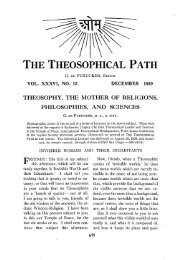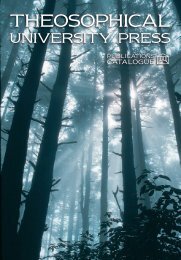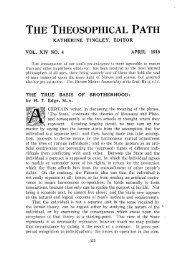To Light a Thousand Lamps - The Theosophical Society
To Light a Thousand Lamps - The Theosophical Society
To Light a Thousand Lamps - The Theosophical Society
You also want an ePaper? Increase the reach of your titles
YUMPU automatically turns print PDFs into web optimized ePapers that Google loves.
<strong>The</strong> Christian Message / 85<br />
most often as a Tree of Life composed of ten Sefīrōt, ten<br />
‘‘numbers’’ or emanations from ’ēin sōf, the boundless,<br />
making a tenfold universe. ‘‘Amid the insupportable brilliance’’<br />
of ’ēin sōf ’ōr, boundless light, they visualized the<br />
head of ’Ādām Qadmōn, Ideal or Archetypal Man, the first<br />
of four Adams which manifest in four Worlds of descending<br />
spiritual stature. <strong>The</strong> fourth Adam on the fourth world,<br />
our earth, ushers in and becomes our present humanity. In<br />
other words, on each of the four worlds a tenfold Tree of<br />
Life, manifesting along with Archetypal Man, clothes itself<br />
in ever more material forms. At length, the fourth world, is<br />
able to sustain the mineral, vegetable, and animal kingdoms;<br />
and on this world humanity, from being originally asexual,<br />
then androgynous, now functions as man and woman.*<br />
In this manner the Zohar interprets the first few verses<br />
of Genesis, commencing with God (really ‘‘gods,’’ ’elohīm),<br />
forming from themselves the heavens (also plural in the<br />
Hebrew) and the earth, which was formless and void until<br />
the quickening when the Spirit of God (rūaḥ ’elohīm,<br />
‘‘breath of the ’elohīm’’) fecundated the waters of space.<br />
During the last 2,000 years the word god has come to<br />
have a very narrow and fixed meaning in contradistinction<br />
to the broad and fluidic connotation it enjoyed all through<br />
the Graeco-Roman world and the Near East. At that time<br />
the relationship between gods and humans was intimate,<br />
*<strong>The</strong> reader is referred to the following sources: Major Trends in<br />
Jewish Mysticism by Gershom G. Scholem, notably the chapter titled:<br />
‘‘<strong>The</strong> Zohar II: <strong>The</strong> <strong>The</strong>osophic Doctrine of the Zohar,’’ p. 202 ¤.;<br />
<strong>The</strong> Zohar, translated by Harry Sperling and Maurice Simon, 5 vols.;<br />
Qabbalah by Isaac Myer; Kabbalah: New Perspectives by Moshe Idel.













